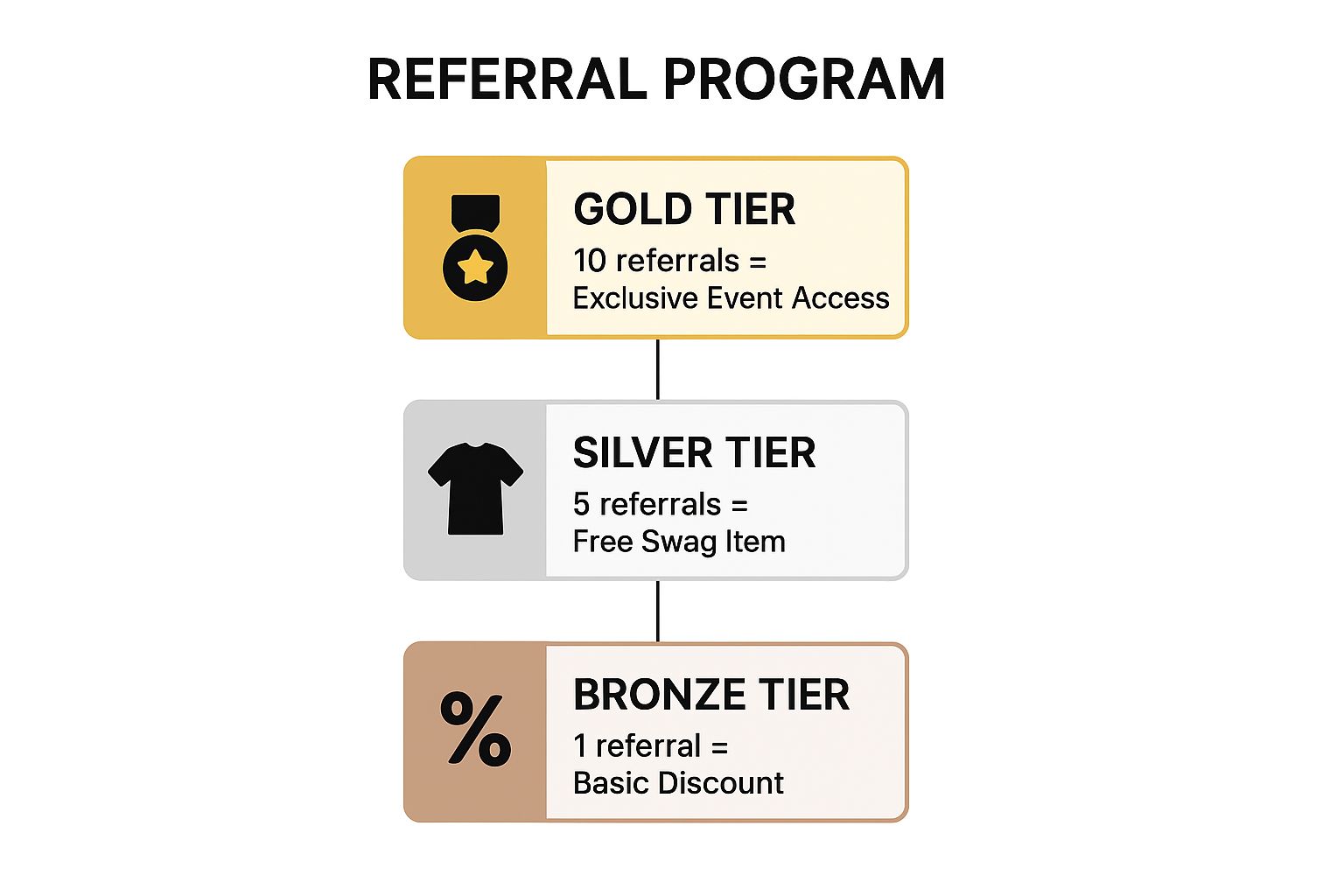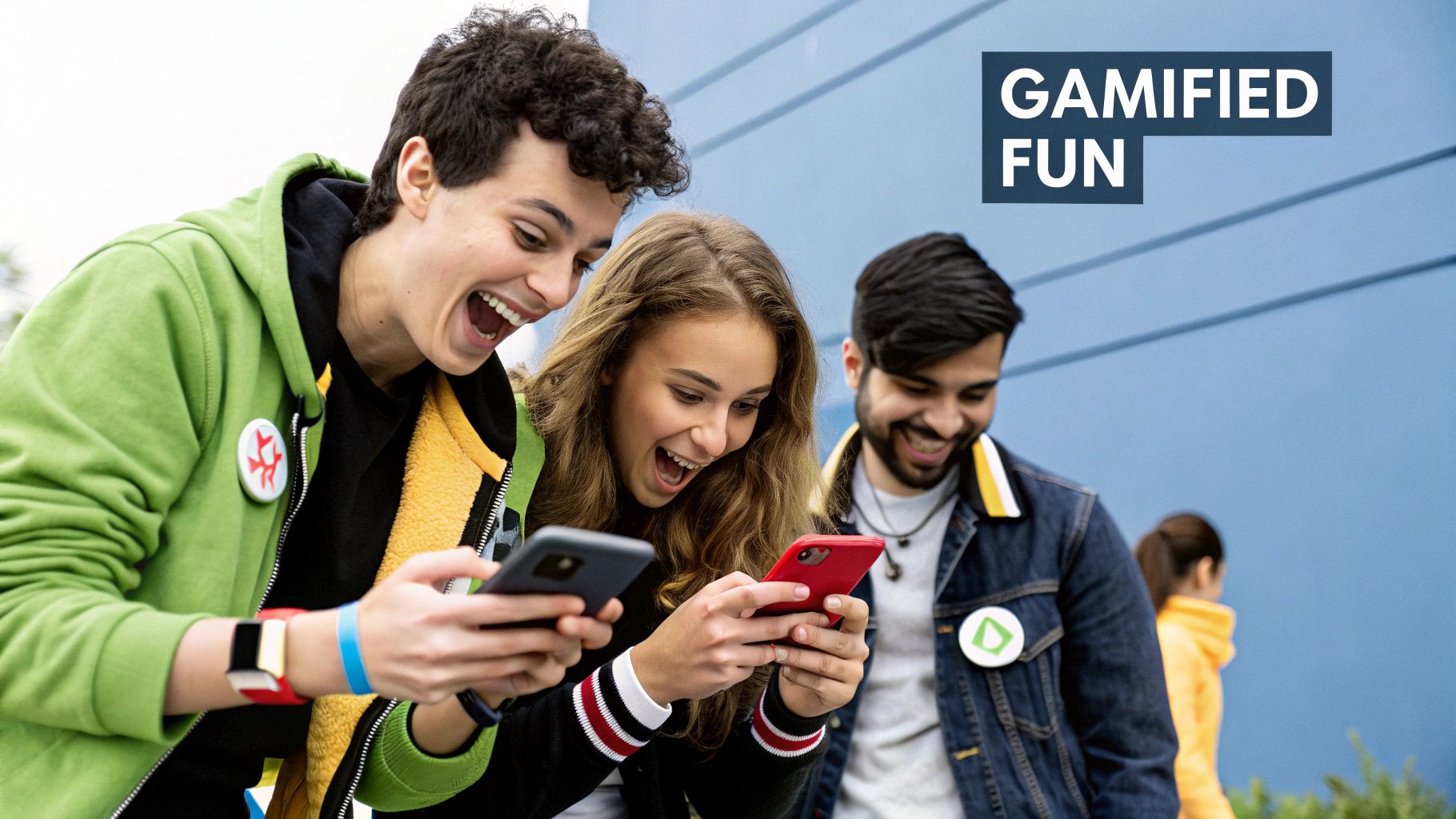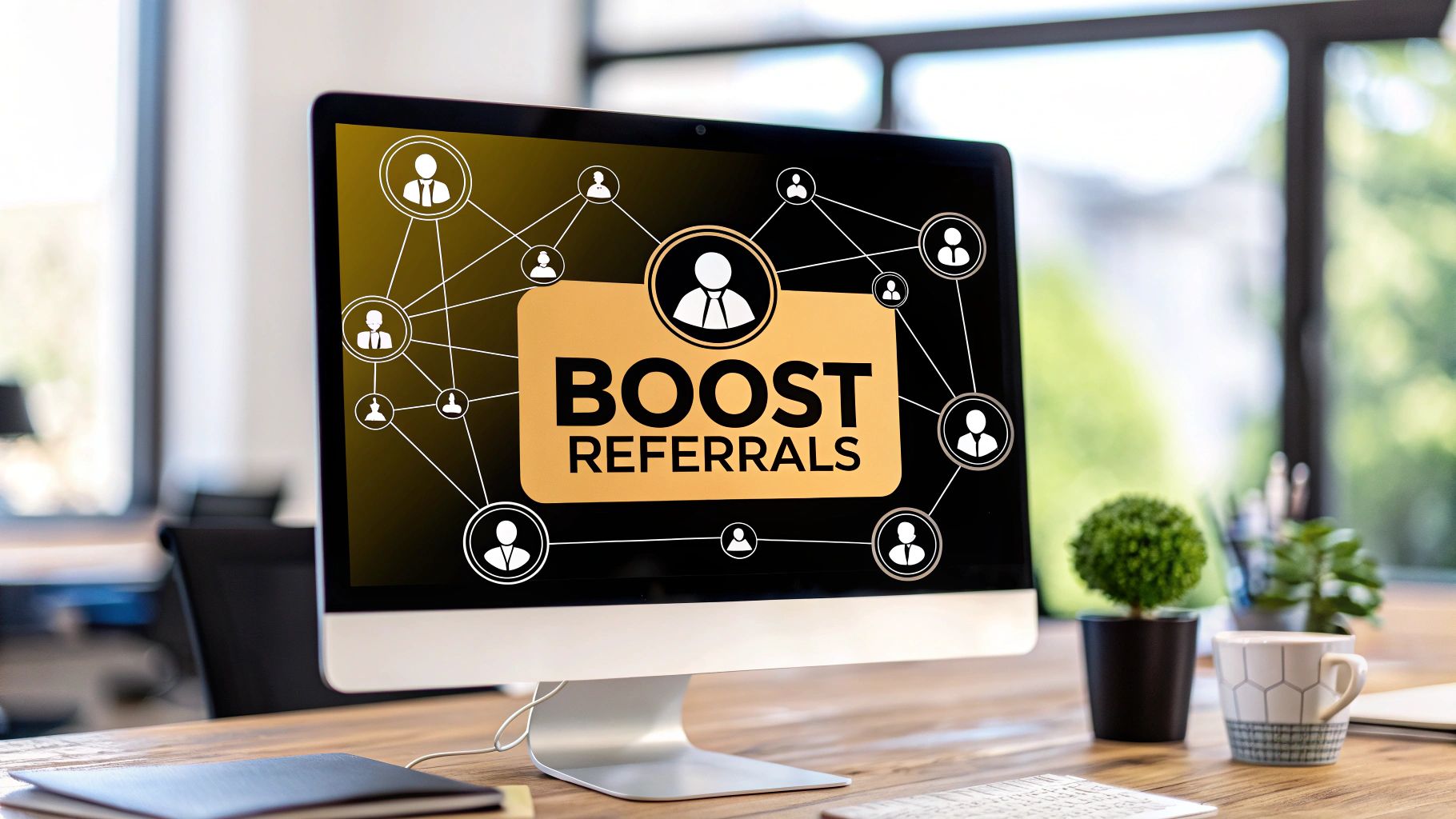Unleash the Power of Word-of-Mouth Marketing
Want to supercharge your growth? Referral program ideas are key to unlocking the potential of word-of-mouth marketing. This listicle delivers eight proven strategies to turn your customers into advocates. Learn how two-sided rewards, tiered programs, gamification, community building, milestone campaigns, partnerships, social sharing, and cause-based initiatives can drive powerful referral program results. Whether you're a startup founder or running a SaaS business, these ideas will help you acquire new customers and boost growth.
1. Two-Sided Reward System
A two-sided reward system, a powerful approach for boosting customer acquisition and engagement, offers incentives to both the referrer (existing customer) and the referee (new customer). This mutually beneficial structure encourages existing customers to actively promote your product or service while simultaneously enticing new customers to try it out. By rewarding both parties, you create a win-win scenario that accelerates growth and fosters a sense of community.

This approach is particularly effective for early-stage startups, self-serve SaaS companies, product-led growth SaaS, SaaS founders, and indie hackers looking for cost-effective and viral growth strategies. It leverages the power of word-of-mouth marketing, turning your existing customer base into enthusiastic brand advocates. Features of a two-sided system include rewarding both the referrer and the referee, offering various incentive types (monetary rewards, discounts, credits, free products/services), and employing a clear reward structure (e.g., "$10 for you, $10 for your friend"). These rewards can be implemented as one-time or recurring benefits, further enhancing their appeal.
The benefits are numerous. Higher conversion rates are achieved due to the dual incentives, creating a sense of fairness and generosity. This shared benefit motivates both parties, accelerating product adoption. This model is particularly effective for subscription-based businesses, encouraging long-term customer loyalty. Think of successful examples like Uber, which gives both the referrer and new user ride credits, or Airbnb, offering travel credits to both parties. Dropbox, famously, gives both users additional storage space, and PayPal's early growth strategy hinged on giving $10 to both the referrer and the referee. These companies leveraged the two-sided reward system to achieve impressive growth, showcasing its potential for viral marketing.
However, two-sided reward systems are not without their drawbacks. They can be more costly than one-sided systems, requiring careful financial modeling to ensure profitability. They may also attract discount-seekers rather than genuinely interested customers. Learn more about Two-Sided Reward System for best practices and in-depth information.
For those considering implementing this powerful referral program idea, consider these actionable tips: Ensure rewards are meaningful enough to motivate action. Factor in your customer acquisition cost (CAC) when designing the reward value. Test different reward values to find the optimal balance between attractiveness and cost-effectiveness. Crucially, make the referral process as frictionless as possible for both parties. Finally, clearly communicate the mutual benefit in all your marketing materials to maximize participation. By following these guidelines, you can leverage the power of two-sided reward systems to drive sustainable growth and build a loyal customer base.
2. Tiered Referral Programs
Tiered referral programs represent a dynamic approach to incentivizing customer referrals by offering increasingly valuable rewards as users successfully refer more people. This gamified structure encourages continuous advocacy, transforming referrals from a one-time action into a habitual activity. Instead of a single reward for each successful referral, tiered programs offer a ladder of rewards, motivating referrers to climb higher by bringing in more customers. This strategy is particularly effective for early-stage startups, self-serve SaaS companies, product-led growth SaaS, SaaS founders, and indie hackers looking to rapidly expand their user base.
The following infographic visualizes the key data and hierarchical structure of a tiered referral program, outlining the increasing rewards associated with higher referral tiers.

As the infographic demonstrates, the tiered structure starts with a base level, often offering a smaller reward or discount. As the referrer successfully brings in more customers, they ascend to higher tiers, unlocking progressively more valuable rewards. This visualization highlights the escalating nature of the rewards and the motivation for continued participation.
The hierarchy visualized above begins with the core concept of "Tiered Referral Program." Branching from this are the key components: increasing referral counts leading to escalating reward tiers. The infographic illustrates this by displaying a progression from Tier 1 with lower referrals and rewards to Tier 3 (and potentially beyond) with higher counts and increasingly valuable rewards. The most important element emphasized is the direct correlation between increased referrals and enhanced rewards, driving continuous engagement. This visual representation makes it clear how the tiered system encourages ongoing referrals.
This approach leverages the principles of gamification to boost engagement and build a loyal community of advocates. Features of a tiered referral program include multiple reward levels based on the number of successful referrals, a progressive reward structure with increasing value at each tier, visual tracking of progress toward the next tier level, and often status recognition alongside material rewards. For instance, a SaaS company might offer a free month of their service at the first tier, a discount on an annual subscription at the second, and exclusive access to beta features or company swag at the third.
Pros:
- Encourages ongoing referral behavior: The promise of better rewards motivates continued participation.
- Gamified experience: Turns advocacy into a fun and engaging activity.
- Identifies and rewards top advocates: Highlights your most valuable customers.
- Increases lifetime referral value: Encourages higher referral rates per customer.
Cons:
- More complex to administer: Requires more planning and tracking than simple referral programs.
- Potential for discouragement: Early tiers need to be attainable to avoid demotivating users.
- Ongoing management: Requires consistent communication and reward updates.
Examples of Successful Implementation:
- Tesla: Offered increasing rewards including exclusive events and free vehicles.
- Morning Brew: Uses a tiered swag program (stickers, mugs, t-shirts, hoodies) based on referral count.
- Harry's Razors: Pre-launch campaign with escalating rewards for more referrals acquired 100,000 email addresses.
- Koodo Mobile: Offers a tiered referral program with increasing bill credits.
Tips for Implementation:
- Set achievable initial thresholds: Encourage early participation by making the first tiers relatively easy to reach.
- Visual progress dashboards: Provide clear visual feedback on referral progress.
- Milestone notifications: Keep participants engaged with regular updates and encouragement.
- Experiential rewards: Consider exclusive experiences for top tiers to create a sense of community and prestige.
- Refresh rewards: Maintain interest by periodically updating the rewards offered.
Tiered referral programs are a powerful tool when you want to cultivate a highly engaged community of advocates and drive significant growth through word-of-mouth marketing. By implementing these tips and learning from successful examples, you can leverage tiered programs to achieve impressive results for your startup or SaaS business. This method deserves its place in this list due to its potential for creating a sustainable and scalable referral engine.
3. Gamified Referral Programs
Gamified referral programs inject fun and engagement into the referral process by incorporating game mechanics. Think points, badges, leaderboards, challenges, and progress bars – elements designed to tap into our natural competitive spirit and desire for recognition. By making referrals feel more like a game, these programs can significantly boost participation and drive more valuable word-of-mouth marketing. This approach is particularly effective for engaging a user base that enjoys interactive experiences and friendly competition, ultimately leading to higher referral rates.

Gamified referral programs leverage features like point systems for each successful referral, achievement badges for reaching milestones, and leaderboards showcasing top referrers. Time-limited challenges and missions introduce a sense of urgency and excitement, while progress bars and other visual feedback mechanisms provide a satisfying sense of accomplishment. Rewards, both virtual (like exclusive badges) and real-world (like gift cards or discounts), further incentivize participation. Think of how Duolingo uses leaderboards and streak systems, or how Starbucks Rewards utilizes star collection and level progression to keep users engaged. Fitbit’s challenges and badges for referring friends, the Google Local Guides program, and Codecademy's achievement badges all exemplify successful gamification. These mechanics turn a simple act of referral into a more interactive and rewarding experience.
For early-stage startups, self-serve SaaS companies, and product-led growth SaaS, gamified referrals can be a particularly effective way to drive organic growth. Learn more about Gamified Referral Programs and how to measure their success. This approach can be more cost-effective than traditional advertising, especially for indie hackers and SaaS founders working with limited budgets. By fostering a sense of community and rewarding user engagement, these programs can significantly reduce customer acquisition costs.
Pros:
- Increased Engagement: The competitive and achievement-oriented nature of gamification boosts user engagement and encourages active participation.
- Enhanced Enjoyment: The referral process becomes more enjoyable and memorable, fostering positive associations with your brand.
- Intrinsic Motivation: Appeals to intrinsic motivations beyond just monetary rewards, fostering genuine enthusiasm.
- Multiple Touchpoints: Provides multiple opportunities for communication and interaction with your users.
- Cost-Effectiveness: Can be more cost-effective than relying solely on monetary incentives.
Cons:
- Complex Implementation: Requires more complex implementation and ongoing maintenance compared to simpler referral programs.
- Limited Appeal: May not resonate with all customer demographics. Some users may find gamification off-putting or irrelevant.
- Focus Shift: There’s a risk of users focusing on the game elements rather than the quality of their referrals.
- Staleness: Can become stale if challenges and rewards aren't regularly refreshed and updated.
Tips for Implementation:
- Simplicity is Key: Keep the game mechanics simple and intuitive. Avoid overwhelming users with complex rules or convoluted systems.
- Visualize Progress: Focus on progress visualization (e.g., progress bars, level-up animations) to maintain user motivation.
- Balance Competition & Collaboration: Strike a balance between fostering healthy competition and encouraging collaborative efforts.
- Varied Achievements: Offer both short-term and long-term achievements to cater to different playing styles.
- Regular Refreshments: Periodically refresh challenges and rewards to keep the program engaging and prevent staleness.
- Meaningful Rewards: Ensure the rewards at each level are meaningful and desirable to your target audience.
Gamified referral programs, popularized by pioneers like Foursquare, Nike+ Run Club, Duolingo, and Starbucks, represent a powerful strategy for boosting customer acquisition and fostering a vibrant, engaged user community. By tapping into the power of play, these programs can transform the referral process from a mundane task into a rewarding and enjoyable experience. This is why gamified referral programs deserve a prominent place in any list of effective referral program ideas, particularly for those targeting tech-savvy audiences.
4. Community-Based Referral Programs
Community-based referral programs represent a powerful approach to growth, especially for early-stage startups, self-serve SaaS companies, product-led growth SaaS, and indie hackers. Instead of relying solely on individual incentives, these programs tap into the power of social connections and shared purpose within a community. Referrals become a natural extension of community engagement, driven by a desire to contribute to the group and provide mutual value to fellow members. This approach builds a stronger, more sustainable foundation for growth compared to traditional transactional referral programs.

This type of referral program thrives on features like group milestones and collective rewards, celebrating community achievements rather than just individual ones. Public recognition for top contributors, shared experiences like exclusive group access, and opportunities for content creation and sharing further strengthen community bonds. Member-to-member endorsements and testimonials become powerful drivers of social proof within the group.
Why This Approach Deserves a Place in Your Referral Program Ideas List:
For businesses focusing on building a loyal customer base, a community-based referral program is essential. It fosters a sense of belonging and shared identity around your brand, creating powerful emotional connections that go far beyond simple transactions. This resonates particularly well with today's consumers, who value authenticity and community engagement.
Examples of Successful Implementation:
- Glossier: Their representative program seamlessly blends referrals with user-generated content, empowering brand advocates within their vibrant online community.
- Peloton: Their community-driven referral approach leverages group challenges and the social dynamics of online fitness classes to incentivize referrals.
- REI Co-op: Their member-get-member program is deeply rooted in their cooperative structure, reflecting their community-focused values.
- Lululemon: Their ambassador program combines community building with referrals, creating local brand advocates who embody the Lululemon lifestyle.
- CrossFit: The tight-knit nature of CrossFit gyms ("boxes") fuels organic referral growth through shared fitness journeys and community events.
Actionable Tips for Implementation:
- Create Connection Hubs: Establish dedicated online forums, Facebook groups, or even physical spaces for community members to connect.
- Share Success Stories: Highlight community stories and achievements to inspire others and demonstrate the value of participation.
- Leverage Community Events: Use events as opportunities to encourage referrals and strengthen community bonds.
- Develop Exclusive Content: Offer exclusive content or experiences only accessible to community members, adding value to belonging.
- Balance Structure and Organicity: Combine structured referral incentives with organic community building activities.
- Appoint Leaders: Consider appointing community leaders or ambassadors to facilitate engagement and encourage referrals.
Pros and Cons:
Pros:
- Creates stronger emotional connections to the brand.
- Leverages social proof and trust within the community.
- Feels more authentic than purely transactional referrals.
- Builds long-term loyalty beyond individual rewards.
- Generates valuable user-generated content.
Cons:
- Takes longer to establish than traditional referral programs.
- Requires ongoing community management and engagement.
- Success depends on having an engaged customer base.
- ROI can be harder to measure precisely.
When and Why to Use This Approach:
Community-based referral programs are particularly effective for businesses that prioritize building strong customer relationships and fostering a sense of community around their brand. This approach is ideal for early-stage startups, self-serve SaaS companies, product-led growth SaaS, and indie hackers looking to cultivate long-term loyalty and generate authentic word-of-mouth marketing. If your target audience values social connections and shared experiences, this referral program idea is well worth exploring.
5. Milestone or Special Occasion Referral Campaigns
Milestone or special occasion referral campaigns inject a dose of excitement and urgency into your standard referral program by tying them to specific events. These events could be anything from holidays like Christmas or Valentine's Day, company anniversaries, product launches, or even customer milestones like their birthday or the anniversary of them joining your service. This tactic is a powerful way to revitalize your referral program and attract new customers, making it a valuable referral program idea for any business, especially early-stage startups, self-serve SaaS companies, and those focused on product-led growth.
How They Work:
The core of a milestone campaign lies in offering enhanced rewards or unique opportunities for a limited time. This could involve doubling the standard referral bonus, offering a special edition gift, providing access to exclusive content, or even creating a tiered reward system where referrers unlock increasingly valuable prizes as they reach specific referral milestones within the campaign period. Countdown timers, themed email campaigns, and dedicated landing pages all contribute to a sense of urgency, prompting immediate action from potential referrers.
Examples of Successful Implementation:
- Uber: Frequently runs double referral credit promotions during holidays, encouraging both riders and drivers to participate.
- Airbnb: Offers seasonal travel referral bonuses tied to popular travel periods, incentivizing users to refer friends for their next vacation.
- Casper: Ran a successful 'National Sleep Day' enhanced referral campaign, capitalizing on a relevant national observance day.
- Robinhood: Offered special stock offerings for referrals during market milestones, attracting new investors to their platform.
- ClassPass: Celebrated anniversaries with referral campaigns that awarded bonus credits, rewarding existing users and attracting new members.
Why This Approach Works:
Milestone campaigns offer several advantages. The time-limited nature creates a sense of FOMO (fear of missing out) that encourages immediate action. Theming the campaign around a specific event provides fresh marketing angles and resonates with your audience in a more engaging way. These campaigns can also reactivate dormant customers or referrers who may not have been actively participating in your standard program. Furthermore, these limited-time campaigns allow you to test different reward structures and gather valuable data without permanently altering your core program. Finally, they generate buzz and provide ample social media sharing opportunities.
Pros:
- Creates urgency and encourages immediate action
- Provides fresh marketing angles for your referral program
- Can reactivate dormant customers or referrers
- Allows testing of different reward structures
- Generates buzz and social media sharing opportunities
Cons:
- Temporary nature means benefits may not sustain long-term
- Can lead to referral fatigue if overused
- Requires additional creative and marketing resources
- Risk of attracting lower-quality leads motivated only by limited-time offers
Actionable Tips for Implementation:
- Plan strategically: Align your campaigns with natural customer decision points, such as holidays, seasonal changes, or product launches.
- Create a calendar: Develop a campaign calendar to space out promotions throughout the year, avoiding referral fatigue.
- Themed creative assets: Design eye-catching visuals and messaging that align with the specific event or milestone.
- Countdown timers: Incorporate countdown elements on landing pages and in emails to reinforce the limited-time offer.
- Follow up: Engage with both successful referrers and new customers after the campaign concludes.
- Analyze performance: Track key metrics and analyze campaign performance to optimize future special promotions.
Why This Deserves a Spot on the List:
Milestone or special occasion referral campaigns are a highly effective way to boost referral activity and acquire new customers. By leveraging the power of urgency, themed promotions, and enhanced rewards, you can generate excitement around your referral program and drive significant growth. For startups and SaaS companies looking for creative and impactful referral program ideas, this strategy is a must-try. The ability to test and iterate with different reward structures within a defined timeframe also makes it a low-risk, high-reward approach.
6. Partner and Affiliate Referral Networks
Partner and affiliate referral networks represent a powerful way to expand your referral program's reach far beyond your existing customer base. Instead of relying solely on customer referrals, this approach leverages the influence and audiences of complementary businesses, influencers, and content creators to promote your product or service. This strategy is particularly effective for early-stage startups, self-serve SaaS companies, product-led growth SaaS, SaaS founders, and indie hackers looking to scale customer acquisition quickly and efficiently. This method deserves a spot on this list of referral program ideas because it offers the potential for exponential growth by tapping into pre-built audiences and leveraging the credibility of established partners.
Here's how it works: you establish formal partnerships with individuals or businesses who have an audience that aligns with your target market. These partners promote your product or service to their audience, and in return, they receive a commission or reward for every successful referral. This model can be highly effective for generating high-quality leads and achieving rapid growth.
Features of Partner and Affiliate Referral Networks:
- Formalized partnership agreements: Clearly define roles, responsibilities, and expectations for both parties.
- Tracking links and attribution systems: Accurate tracking is crucial for properly rewarding partners and measuring program effectiveness.
- Tiered commission or reward structures: Incentivize partners to perform better by offering higher rewards for increased referrals.
- Co-branded marketing materials: Provide partners with pre-made assets to simplify the promotion process.
- Partner portals or dashboards: Give partners access to performance data, marketing materials, and other resources.
- Revenue sharing or performance-based incentives: Align partner success with your own by tying rewards directly to revenue generation.
Pros:
- Accesses larger, pre-established audiences: Reach potential customers you wouldn't organically reach through customer referrals alone.
- Leverages partners' credibility and trust: Benefit from the established trust partners have built with their audience.
- Can scale customer acquisition more quickly than organic referrals: Achieve faster growth by leveraging the collective reach of multiple partners.
- Provides professional marketing support through partners: Gain access to marketing expertise and resources from your partners.
- Often results in higher-quality leads than general advertising: Partners often have highly engaged audiences who are more likely to convert.
Cons:
- Higher reward costs than standard customer referrals: Be prepared to invest more in rewards due to the greater value provided by partners.
- Requires more complex tracking and attribution: Managing multiple partner relationships and accurately tracking referrals requires robust systems.
- Potential brand alignment issues with some partners: Carefully vet partners to ensure their values align with your brand.
- May cannibalize organic referrals: Monitor your program to ensure it's not detracting from existing referral channels.
- Needs dedicated partnership management resources: Building and maintaining successful partnerships requires dedicated time and effort.
Examples of Successful Implementations:
- Amazon Associates: One of the most well-known affiliate programs, connecting businesses with a vast network of website owners and bloggers.
- HubSpot's Solutions Partner Program: Enables agencies to expand their services and reach new clients.
- Shopify's Partner Program: Empowers developers and designers to build and sell Shopify apps and themes.
- Blue Apron's blogger and influencer partnerships: Leveraged food bloggers and influencers to promote meal kits to their audiences.
- Coinbase's ambassador program: Utilizes crypto influencers to expand reach and educate potential users.
Tips for Success:
- Develop clear guidelines and expectations for partners: Set clear performance metrics and communication standards.
- Create ready-to-use marketing materials and messaging templates: Equip partners with the tools they need to effectively promote your product.
- Implement robust tracking to accurately attribute referrals: Ensure accurate measurement and fair compensation for partners.
- Offer tiered commission structures based on volume or quality: Incentivize top performers with higher rewards.
- Provide regular performance updates and optimization suggestions: Help partners improve their performance and maximize results.
- Consider exclusive offerings or custom landing pages for top partners: Reward high-performing partners with special incentives.
- Regularly review partner performance and prune underperforming relationships: Focus on maintaining relationships with valuable partners. When seeking out influencers for your referral program, consider leveraging micro-influencer marketing platforms to streamline the process of identifying and partnering with relevant influencers. These platforms can help connect you with influencers whose audience aligns with your target demographic, simplifying the partnership process.
Learn more about Partner and Affiliate Referral Networks
7. Social Sharing and Content-Driven Referrals
Social sharing and content-driven referral programs represent a powerful way to leverage the organic reach of your existing customer base and tap into the persuasive power of user-generated content. This approach, ideal for early-stage startups, self-serve SaaS companies, product-led growth SaaS, SaaS founders, and indie hackers looking for cost-effective growth strategies, moves beyond simple one-to-one referrals and encourages customers to become brand advocates by creating and sharing content featuring your product or service. This content, naturally integrated with referral opportunities, exposes your brand to a wider audience within the context of authentic user experiences. If you're looking for innovative referral program ideas, this one deserves a spot on your list.
How it Works:
Instead of directly asking for referrals, you provide customers with the tools and incentives to showcase how they use and benefit from your product. This could involve shareable content templates, easy social media integration with pre-populated referral links, or even hashtag campaigns that encourage user-generated content around specific themes. Essentially, you're turning your customers into content creators and micro-influencers for your brand.
Features:
- Shareable Content Templates and Generators: Pre-designed templates for various social media platforms make it easy for customers to create high-quality, on-brand content.
- Social Media Integration with Referral Links: Seamless integration allows for easy sharing with automatically embedded referral links.
- Hashtag Campaigns and Challenges: Engaging campaigns and challenges centered around your brand or product encourage user participation and content creation.
- User-Generated Content Contests and Showcases: Incentivize high-quality content creation by showcasing and rewarding top contributors.
- Visual Referral Assets (images, videos, stories): Provide visually appealing assets that are easily shareable across different platforms.
- Incentives for both Sharing and Successful Conversions: Reward both the sharing of content and the successful conversion of referrals.
Examples:
- Glossier: Built a thriving community by encouraging customers to share their makeup looks featuring Glossier products on Instagram.
- Warby Parker: Facilitates social sharing by allowing customers to virtually try on eyewear and share their looks with referral links.
- Rothy's: Leveraged sustainability-focused content sharing to highlight their eco-friendly practices and incentivize referrals.
- Outdoor Voices: Utilized the #DoingThings hashtag to build a community and encourage customers to share their active lifestyles while incorporating referral opportunities.
- Airtable: Allows users to share templates with embedded referral mechanisms, making it easy to recommend the platform while providing valuable resources.
Pros:
- Extended Reach: Goes beyond direct personal networks to reach broader audiences.
- Authentic Social Proof: User-generated content builds trust and credibility.
- Dual Marketing Benefit: Drives referrals while simultaneously increasing brand awareness.
- Reusable Marketing Assets: Customer content can be repurposed for other marketing initiatives.
- Appeals to Digitally-Native Consumers: Aligns with the sharing habits of younger demographics.
Cons:
- Less Personal: Lacks the personal touch of a direct recommendation.
- Effectiveness Depends on Customer Engagement: Relies on customers having an active and engaged social media presence.
- Content Quality Control: User-generated content can vary in quality.
- Attribution Challenges: Tracking the precise source of referrals can be more complex.
- Platform Algorithm Dependence: Subject to changes in social media algorithms.
Tips for Implementation:
- Create Visually Appealing Templates: Design branded templates that are easy to use and customize.
- Streamline Sharing: Implement one-click sharing tools for all major social platforms.
- Provide Sharing Guidance: Offer tips on effective sharing practices and captions.
- Tailor to Each Platform: Adapt your approach to the specific nuances of each social media platform (Instagram, TikTok, LinkedIn, etc.).
- Highlight and Reward User-Generated Content: Showcase and reward exceptional content to encourage further participation.
- Leverage Testimonials: Encourage customers to share their testimonials and experiences.
- Experiment with Visual Formats: Test different formats (images, videos, stories) to determine what resonates most with your audience.
When to Use This Approach:
This type of referral program is particularly effective for businesses with a strong visual component, a vibrant online community, and a target audience active on social media. It's an excellent choice for startups and SaaS companies looking to build brand awareness, generate social proof, and drive organic growth through authentic customer advocacy. By empowering your customers to become brand ambassadors, you can unlock the immense potential of social sharing and content-driven referrals.
8. Nonprofit and Cause-Based Referral Programs
Nonprofit and cause-based referral programs offer a unique approach to customer acquisition by aligning it with social impact. Instead of (or in addition to) traditional rewards like discounts or free products, these programs trigger a donation to a charitable cause or support a meaningful initiative with every successful referral. This strategy taps into the growing consumer desire to make a positive difference, creating a triple win: a new customer for your business, support for a worthy cause, and a feel-good factor for the referring customer. This makes it a powerful referral program idea, especially for early-stage startups, self-serve SaaS companies, product-led growth SaaS, SaaS founders, and indie hackers looking to differentiate themselves and build a strong brand reputation.
How it Works:
A customer refers a friend to your business. When the friend completes a qualifying action (e.g., makes a purchase, signs up for a trial), a pre-determined donation is made to a chosen charity or cause. The referring customer is informed of the impact their referral has made, reinforcing the positive association with your brand.
Features:
- Donations to charities or causes: Replacing or supplementing traditional referral rewards.
- Impact transparency and reporting: Clearly communicating the impact of referrals.
- Choice of causes or charitable organizations: Allowing customers to select their preferred cause.
- Co-branded campaigns with nonprofit partners: Amplifying reach and impact.
- Storytelling components highlighting real impact: Connecting customers with the cause emotionally.
- Seasonal or response-based cause campaigns: Tying referrals to specific events or needs.
Examples:
- TOMS: Extended their "One for One" model to referrals.
- Warby Parker: Integrates their "Buy a Pair, Give a Pair" program with referrals.
- Bombas: Donates socks with every purchase made through a referral.
- Patagonia: Supports environmental causes through referral initiatives.
- Tentree: Plants trees for every referral, directly impacting environmental conservation.
Pros:
- Appeals to socially conscious consumers: Attracts a growing segment of customers motivated by ethical considerations.
- Enhances brand reputation and social responsibility profile: Builds trust and positive brand perception.
- Creates emotional connection beyond transactional relationships: Fosters deeper customer loyalty.
- Can generate positive PR and media coverage: Attracts attention and builds brand awareness.
- Differentiates from competitors with standard referral programs: Stands out in a crowded market.
- May attract customers who wouldn't respond to traditional incentives: Expands your potential customer base.
Cons:
- May not appeal to all customer segments: Some customers may prefer direct rewards.
- Requires authentic commitment to causes (avoid 'cause-washing'): Lack of sincerity can damage your brand.
- Impact may be harder to track than direct revenue metrics: Requires different evaluation methods.
- Requires careful selection of aligned nonprofit partners: Ensures credibility and effectiveness.
- Can be politically sensitive depending on causes selected: Requires careful consideration and due diligence.
Tips for Implementation:
- Select causes that authentically align with your brand values: Ensures genuine connection and avoids "cause-washing."
- Provide impact transparency showing exactly how referrals translate to good: Builds trust and reinforces the positive impact.
- Consider offering a choice of causes to accommodate different interests: Increases customer engagement and reach.
- Balance cause marketing with clear communication of product benefits: Avoids overshadowing your core offerings.
- Create compelling visual assets showing real impact: Connects with customers emotionally.
- Partner with established organizations with track records of effectiveness: Ensures donations are used responsibly.
- Share impact stories featuring real beneficiaries (with appropriate permissions): Humanizes the cause and strengthens the emotional connection.
Why This Referral Program Idea Deserves Its Place:
In today's increasingly socially conscious landscape, cause-based referral programs are a powerful way to differentiate your brand, attract customers, and make a real difference. They resonate particularly well with millennial and Gen Z consumers, who prioritize ethical and sustainable practices. For startups and SaaS companies, especially those with limited marketing budgets, this approach can be a highly effective and cost-efficient way to generate organic growth and build a loyal customer base. By aligning your business with a worthy cause, you're not just acquiring customers; you're building a community around shared values. This is particularly relevant for product-led growth SaaS companies, where community and word-of-mouth are crucial drivers of growth.
Referral Program Strategies Comparison
| Strategy | 🔄 Implementation Complexity | 🛠️ Resource Requirements | 📊 Expected Outcomes | 💡 Ideal Use Cases | ⭐ Key Advantages |
|---|---|---|---|---|---|
| Two-Sided Reward System | Moderate (clear reward structure) | Medium (cost of rewards for two sides) | High mutual motivation; increased conversion | Subscription services; products needing quick adoption | Balanced incentives boost conversion; fairness perception |
| Tiered Referral Programs | High (multiple levels, tracking) | High (ongoing management & communication) | Sustained referral activity; increased lifetime value | Brands seeking continuous referral growth | Gamifies advocacy; rewards top advocates |
| Gamified Referral Programs | High (game mechanics + maintenance) | High (design, development, updates) | Increased engagement; competitive participation | Brands targeting motivated, competitive users | Fun, memorable process; appeals to intrinsic motivation |
| Community-Based Referral Programs | High (community management) | High (ongoing engagement & events) | Strong emotional brand connection; long-term loyalty | Businesses with active user communities | Leverages social proof; builds authentic brand loyalty |
| Milestone or Special Occasion Campaigns | Moderate (time-limited setup) | Medium to High (creative & promotional resources) | Immediate action spikes; buzz generation | Seasonal promotions; product launches | Creates urgency; revitalizes dormant users |
| Partner and Affiliate Referral Networks | High (partnerships + tracking) | High (management & specialized tracking) | Rapid scaling; high-quality leads | Businesses leveraging influencer or agency networks | Access to large, credible audiences; scalable acquisition |
| Social Sharing and Content-Driven Referrals | Moderate (content tools + integration) | Medium (content creation & social media management) | Extended reach; brand awareness plus referrals | Digitally native audiences; social media active customers | Generates authentic social proof; reusable marketing assets |
| Nonprofit and Cause-Based Referral Programs | Moderate (partnership and impact tracking) | Medium (partner relations and storytelling) | Emotional connection; positive brand reputation | Brands aiming for social impact alignment | Appeals to socially conscious consumers; differentiates brand |
Ready to Ignite Your Referral Program?
From two-sided rewards and tiered programs to gamified challenges and community-driven initiatives, this article has explored a wealth of referral program ideas to fuel your growth. The key takeaway is that a successful referral program hinges on understanding your audience and offering them compelling incentives to share your product or service. Whether you're leveraging social sharing, partnering with affiliates, or tapping into the power of milestone campaigns, the right approach can transform satisfied customers into your most effective marketing channel. Mastering these referral program ideas is invaluable because it allows you to unlock the organic growth potential within your existing customer base, driving acquisition costs down and building a loyal community of advocates. This translates to not just more customers, but a more sustainable and cost-effective growth trajectory for your business.
Remember, finding the perfect referral program is an iterative process. Experiment, analyze your results, and refine your approach based on what resonates best with your audience. Ready to streamline your referral program implementation and unlock its full potential? Explore how Refgrow can automate tracking, simplify management, and help you build a thriving referral program tailored to your unique business needs. Supercharge your growth with Refgrow and watch your customer base expand organically.

